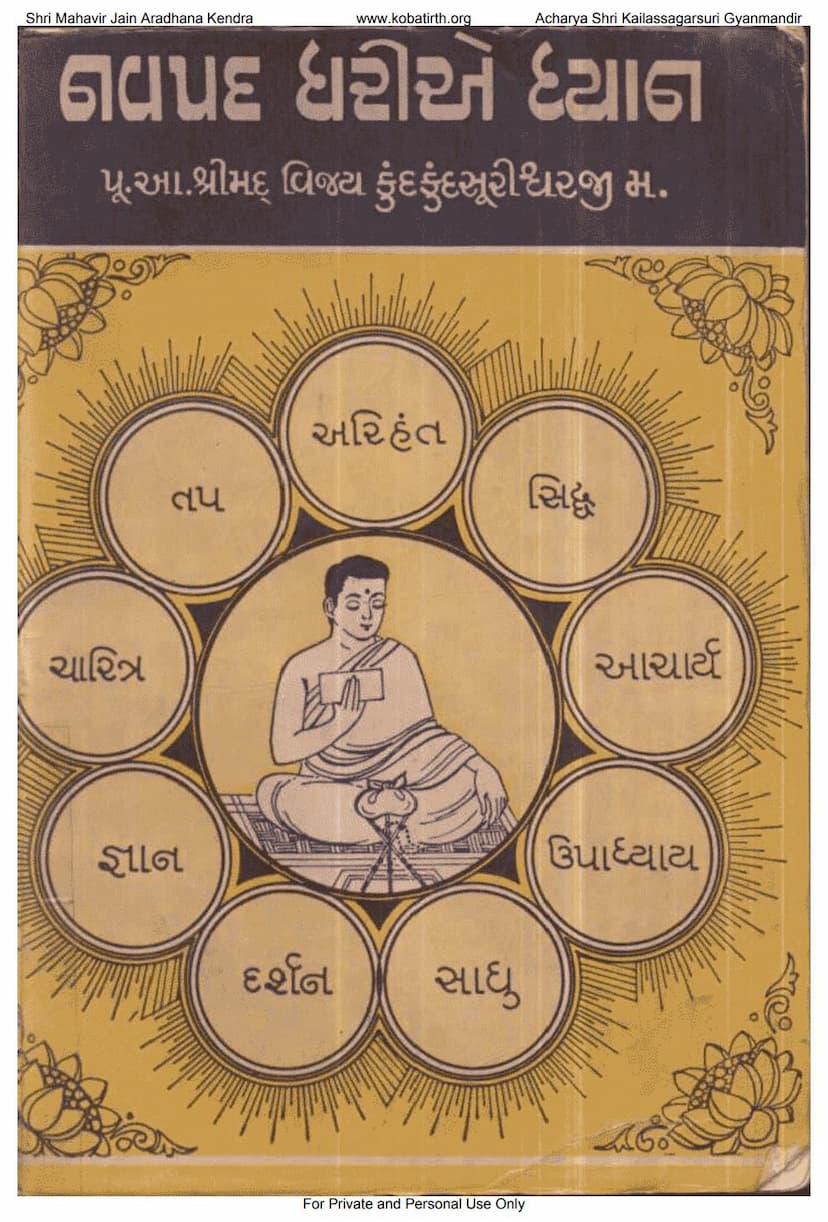Navpad Dharie Dhyan
Added to library: September 2, 2025

Summary
This document is a Gujarati-language Jain text titled "Navpad Dharie Dhyan" (Meditation on the Nine Sacred Entities), authored by Kundkundsuri and Vajrasenvijay, and published by Smruti Granth Samiti. The catalog link provided is for JainQQ.org.
The book focuses on the profound significance and practice of meditating on the Navapada (Nine Sacred Entities) in Jainism. The Navapada are presented as the core essence of the Jain faith, and their worship is considered essential for achieving liberation (Moksha).
Here's a breakdown of the content based on the provided pages:
Core Concept: The Navapada
The Navapada are identified as:
- Arihant: The liberated souls who have conquered their inner enemies (kashayas) and revived the Jain path.
- Siddha: The souls who have attained eternal liberation, residing in Siddhashila.
- Acharya: The spiritual leaders who guide the Sangha and uphold Jain principles.
- Upadhyaya: Those who are proficient in the scriptures and impart knowledge to others.
- Sadhu: The monks who diligently follow the vows and principles of Jainism.
- Darshan: Right Faith (Samyak Darshan) - Faith in the eternal truths and principles of Jainism.
- Gyan: Right Knowledge (Samyak Gyan) - Accurate and complete knowledge of reality.
- Charitra: Right Conduct (Samyak Charitra) - Living life in accordance with the principles of Right Knowledge and Faith.
- Tapa: Austerity and self-discipline, which helps in shedding karmas.
Central Theme: Meditation and Worship of Navapada
The book emphasizes that worship and meditation on these nine sacred entities is the direct path to Moksha. It highlights that even without worshipping at least one of these Navapada, one cannot attain liberation. The text draws parallels with historical figures like Shripal and Mayana, whose devotion to the Navapada led to their spiritual advancement. The book illustrates how meditating on each of the Navapada can help sever the bonds of karma and lead to the ultimate liberation.
Structure and Content:
-
Introduction: The editors and gurus express their gratitude and provide context for the book, highlighting the spiritual significance of the Navapada and the lineage of gurus who have propagated this knowledge. They credit the guidance of their spiritual predecessors, including Acharya Shrimad Vijay Kundakundsuri, for the compilation of this work.
-
The Nine Entities in Detail: The subsequent pages (starting from page 11) delve into each of the Navapada, explaining their unique qualities, significance, and the methods of their worship and meditation.
- Arihant Pad (Page 19 onwards): Discusses the supreme qualities of Arihantas, their twelve principal virtues, and emphasizes the importance of meditating on them, citing the story of Devpal as an example of the transformative power of Arihant devotion. It also details the rituals for worshipping the Arihant pada, including the significance of specific colors (white), offerings, and prayers.
- Siddha Pad (Page 49 onwards): Explains the state of Siddhas, their eight principal virtues, and the 15 classifications of Siddhas. It describes their eternal abode on Siddhashila and the unparalleled bliss of liberation.
- Acharya Pad (Page 72 onwards): Details the role of Acharyas in upholding and propagating the Jain teachings, their fivefold conduct (Pancha Achara), and their importance in guiding the Sangha. It mentions several prominent Acharyas in Jain history who exemplified these virtues.
- Upadhyaya Pad (Page 104 onwards): Focuses on the role of Upadhyayas in studying and teaching scriptures, highlighting their 25 principal virtues and their significance in preserving and disseminating Jain knowledge.
- Sadhu Pad (Page 131 onwards): Explains the path of a Sadhu, their 27 principal virtues, the importance of the five great vows (Mahavratas), and their role in helping souls attain liberation. It recounts the stories of Jambu Swami and Prabhavami Muni as examples of the power of Sadhu devotion.
- Darshan Pad (Page 166 onwards): Discusses the importance of Right Faith (Samyak Darshan) as the foundation of spiritual progress, elaborating on its 67 components and the story of Mahasati Sulsa as an illustration of unwavering faith.
- Gyan Pad (Page 194 onwards): Explores Right Knowledge (Samyak Gyan), its five types, and how it helps distinguish between the real (Atman) and the unreal (Pudgala). It emphasizes the importance of knowing the essence of the soul.
- Charitra Pad (Page 223 onwards): Details Right Conduct (Samyak Charitra), its importance in aligning actions with knowledge and faith, and its role in spiritual purification. It outlines the significance of various vows and practices.
- Tapa Pad (Page 253 onwards): Focuses on Austerity (Tapa) as a means to shed karmas and purify the soul. It explains the six external and six internal types of austerities and highlights their importance in achieving spiritual progress. It also mentions the story of Damayanti to illustrate the power of devotion and austerity.
-
Worship Procedures: For each Navapada, the book provides specific details about the accompanying rituals, including the number of circumambulations, prostrations (Khama-Samana), sacred symbols (Sathiya), recitation of mantras (Navkarvali), and the recommended colors for worship and attire.
-
The Philosophy of Tapa: The section on Tapa emphasizes the practice of Ayambil (eating a single meal per day with specific restrictions) and explains its different types (Shreshtha, Madhyam, Samanya) and their spiritual benefits.
Overall Message:
The book "Navpad Dharie Dhyan" serves as a comprehensive guide for Jain practitioners, detailing the spiritual path through the lens of the Navapada. It aims to inspire readers to cultivate deep devotion, practice rigorous meditation, and adhere to the tenets of Jainism to attain ultimate liberation. The stories and explanations within the text are intended to provide practical guidance and spiritual encouragement for the spiritual journey.